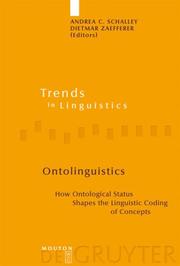| Listing 11 - 20 of 20 | << page >> |
Sort by
|
Digital

ISBN: 9783110780888 9783110780949 9783110780772 Year: 2022 Publisher: Berlin ;; Boston De Gruyter
Abstract | Keywords | Export | Availability | Bookmark
 Loading...
Loading...Choose an application
- Reference Manager
- EndNote
- RefWorks (Direct export to RefWorks)


ISBN: 9783110197792 9783110189971 Year: 2008 Publisher: Berlin ;; Boston De Gruyter Mouton
Abstract | Keywords | Export | Availability | Bookmark
 Loading...
Loading...Choose an application
- Reference Manager
- EndNote
- RefWorks (Direct export to RefWorks)
Book

ISBN: 9783110608694 9783110607987 3110608057 3110608693 3110607980 Year: 2019 Publisher: Berlin Boston
Abstract | Keywords | Export | Availability | Bookmark
 Loading...
Loading...Choose an application
- Reference Manager
- EndNote
- RefWorks (Direct export to RefWorks)
Multimodality's popularity as a semiotic approach has not resulted in a common voice yet. Its conceptual anchoring as well as its empirical applications often remain localized and disparate, and ideas of a theory of multimodality are heterogeneous and uncoordinated. For the field to move ahead, it must achieve a more mature status of reflection, mutual support, and interaction with regard to both past and future directions. The red thread across the disciplines reflected in this book is a common goal of capturing the mechanisms of synergetic knowledge construction and transmission using diverse forms of expressions, i.e., multimodality. The collection of chapters brought together in the book reflects both a diversity of disciplines and common interests and challenges, thereby establishing an excellent roadmap for the future. The contributions revisit and redefine theoretical concepts or empirical analyses, which are crucial to the study of multimodality from various perspectives, with a view towards evolving issues of multimodal analysis. With this, the book aims at repositioning the field as a well-grounded scientific discipline with significant implications for future communication research in many fields of study.
Book

ISBN: 3110725002 9783110725001 9783110724912 311072491X Year: 2021 Publisher: Berlin Boston
Abstract | Keywords | Export | Availability | Bookmark
 Loading...
Loading...Choose an application
- Reference Manager
- EndNote
- RefWorks (Direct export to RefWorks)
This volume advances the data-based study of multimodal artefacts and performances by showcasing methods and results from the latest endeavors in empirical multimodal research, representing a vibrant international and interdisciplinary research community. The collated chapters identify and seek to inspire novel, mixed-method approaches to investigate meaning-making mechanisms in current communicative artifacts, designs, and contexts; while attending to their immersive, aesthetic, and ideological dimensions. Each contribution details innovative aspects of empirical multimodality research, offering insights into challenges evolving from quantitative approaches, particular corpus work, results from eye-tracking and psychological experiments, and analyses of dynamic interactive experiences. The approaches and results presented foreground the inherent multidisciplinary nature and implications of multimodality, renegotiating concepts across linguistics, media studies, (social) semiotics, game studies, and design. With this, the volume will inform both current and future developments in theory, methods, and transdisciplinary contexts and become a landmark reference for anyone interested in the empirical study of multimodality.
Book

ISBN: 9783110883527 Year: 2011 Publisher: Berlin Boston
Abstract | Keywords | Export | Availability | Bookmark
 Loading...
Loading...Choose an application
- Reference Manager
- EndNote
- RefWorks (Direct export to RefWorks)
Digital

ISBN: 9783110608694 9783110608052 9783110607987 Year: 2019 Publisher: Berlin ;; Boston De Gruyter
Abstract | Keywords | Export | Availability | Bookmark
 Loading...
Loading...Choose an application
- Reference Manager
- EndNote
- RefWorks (Direct export to RefWorks)
Digital

ISBN: 9783110725001 9783110725155 9783110724912 Year: 2021 Publisher: Berlin ;; Boston De Gruyter
Abstract | Keywords | Export | Availability | Bookmark
 Loading...
Loading...Choose an application
- Reference Manager
- EndNote
- RefWorks (Direct export to RefWorks)


ISBN: 9783110883527 9783110127409 Year: 2011 Publisher: Berlin ;; Boston De Gruyter Mouton
Abstract | Keywords | Export | Availability | Bookmark
 Loading...
Loading...Choose an application
- Reference Manager
- EndNote
- RefWorks (Direct export to RefWorks)
Digital

ISBN: 9783110255478 9783110394696 9783110255454 Year: 2016 Publisher: Berlin ;; Boston De Gruyter Mouton
Abstract | Keywords | Export | Availability | Bookmark
 Loading...
Loading...Choose an application
- Reference Manager
- EndNote
- RefWorks (Direct export to RefWorks)
Digital

ISBN: 9783110255492 9783110370522 9783110255485 Year: 2014 Publisher: Berlin ;; Boston De Gruyter Mouton
Abstract | Keywords | Export | Availability | Bookmark
 Loading...
Loading...Choose an application
- Reference Manager
- EndNote
- RefWorks (Direct export to RefWorks)
| Listing 11 - 20 of 20 | << page >> |
Sort by
|

 Search
Search Feedback
Feedback About UniCat
About UniCat  Help
Help News
News